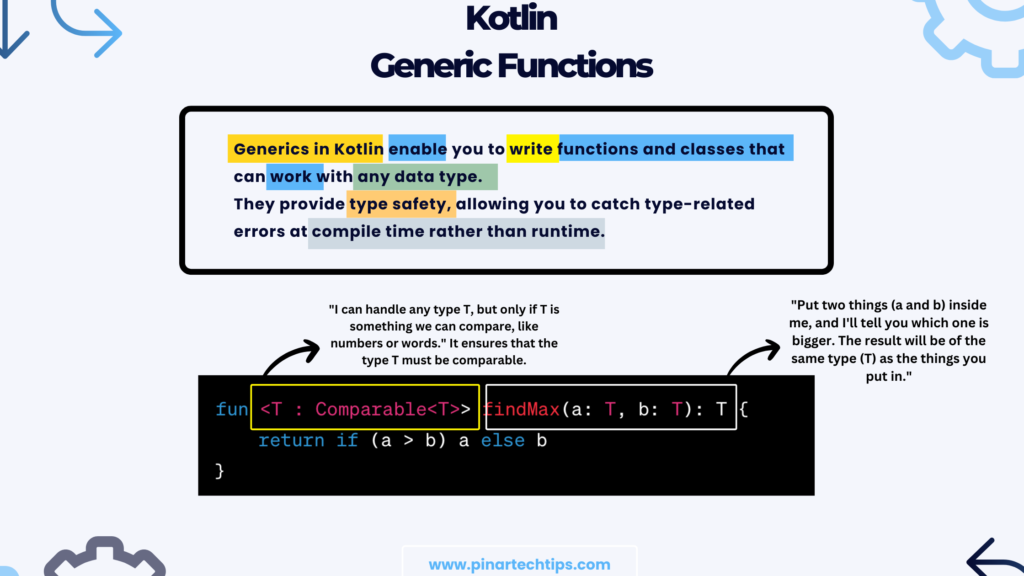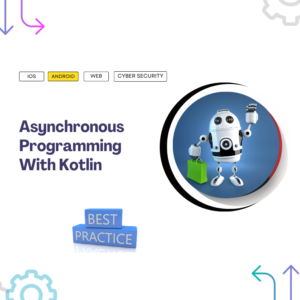Generics in Kotlin enable you to write functions and classes that can work with any data type. They provide type safety, allowing you to catch type-related errors at compile time rather than runtime.

Table of Contents
What are Generic Functions?
Generic functions are functions that can work with different types while ensuring type safety. They allow you to write functions without specifying the exact data type, making the code more versatile and reusable.
What are the advantages of generics in Kotlin?
| Aspect | Description |
|---|---|
| Type Safety | Generics enforce type constraints, validating data types at compile-time to prevent runtime errors. |
| Code Reusability | Generics enable versatile functions and classes, reducing code duplication and promoting reuse. |
| Collections & Algorithms | Generics create type-safe data structures and adaptable algorithms, ensuring seamless interactions. |
| API Design | Generics allow the design of flexible APIs, accommodating various data types for improved usability. |
| Performance Optimization | Generics enhance performance by optimizing bytecode, ensuring efficient execution at runtime. |
| Readability & Maintainability | Generics improve code readability and simplify maintenance, especially in complex codebases. |
| Domain-Specific Scenarios | Generics enable the creation of expressive, type-safe constructs for specialized applications, enhancing language development. |
Declaring Generic Functions
In Kotlin, you can declare generic functions by using angle brackets <T>, where T is a type parameter. These type parameters act as placeholders for actual types. This allows you to write functions that can work with different types of data while maintaining type safety.
Code Example: Let’s create a generic function that takes two parameters and returns the maximum of the two. This function will work with any comparable data type.
fun <T : Comparable<T>> findMax(a: T, b: T): T {
return if (a > b) a else b
}
fun main() {
val maxInt = findMax(5, 10)
val maxString = findMax("apple", "banana")
println("Max Int: $maxInt")
println("Max String: $maxString")
}
Output:
Max Int: 10
Max String: banana
Type Parameters
Type parameters are placeholders for types in generic functions or classes. They allow you to specify that a function or class can work with various types of data. Type parameters are defined using angle brackets, and you can use any letter or word as a type parameter (commonly T, E, K, etc.). Type parameters provide flexibility and allow you to write more versatile and reusable code.
We’ll use the same findMax function from the previous example. Here, T is a type parameter that represents the data type of the parameters and the return value.
Type Constraints
Type constraints are rules or conditions that you can apply to type parameters. They help restrict the types that can be used with a generic function or class. For example, you can specify that the type parameter must implement a particular interface or inherit from a specific class.
Code Example: Let’s add a type constraint to the findMax function to ensure that the type parameter T is a Comparable type. This constraint ensures that the function can only be used with types that support comparison.
fun <T : Comparable<T>> findMax(a: T, b: T): T {
return if (a > b) a else b
}
In this example, : Comparable<T> is the type constraint, indicating that T must be a type that can be compared (i.e., it must implement the Comparable interface).
How do you create a generic class?
Creating a generic class involves declaring a type parameter (e.g., T) for the class and using it within the class to define properties, methods, and behavior. You can create generic classes for various purposes, from data structures like lists to more complex domain-specific classes.
Code Example: Let’s create a simple generic Box class that can hold any type of value. It demonstrates the concept of a generic class with a single type parameter.
class Box<T>(private val value: T) {
fun getValue(): T {
return value
}
}
fun main() {
val intBox = Box(42)
val stringBox = Box("Hello, Kotlin!")
println("Int Box: ${intBox.getValue()}")
println("String Box: ${stringBox.getValue()}")
}
Int Box: 42
String Box: Hello, Kotlin!
Using Generic Classes
Once you’ve created a generic class, you can use it in your code just like any other class. You can create instances of the class with different types, providing flexibility and type safety.
Code Example: The previous code example demonstrates using a generic class. You can create instances of Box with different data types and access their values.
Variance in Generic Types
Variance in generic types is about understanding how subtyping relationships (e.g., inheritance) apply to generic types. It helps you determine when you can safely use a more specific or more general type in the context of generic classes.
Code Example: To understand covariance, consider a Fruit class and a Box class that holds fruits. We’ll explore when you can safely use a Box<Apple> where a Box<Fruit> is expected and vice versa.
open class Fruit
class Apple : Fruit
class Box<out T>(private val value: T) {
fun getValue(): T {
return value
}
}
fun main() {
val appleBox: Box<Apple> = Box(Apple())
val fruitBox: Box<Fruit> = appleBox
println("Fruit Box Value: ${fruitBox.getValue()}")
}
Output:
Fruit Box Value: Fruit@7b3300
In this example, we explore covariance (the use of out) to understand when it’s safe to treat a Box<Apple> as a Box<Fruit).
Working with Generic Lists, Sets, and Maps
Kotlin provides generic collections, such as lists, sets, and maps, which allow you to work with various data types while ensuring type safety.
Code Example: Let’s create a generic list and add elements of different data types to demonstrate how generic collections work.
val genericList = mutableListOf<Any>()
genericList.add(42)
genericList.add("Hello, Kotlin!")
for (item in genericList) {
println("Item: $item")
}
Item: 42
Item: Hello, Kotlin!
Using Extension Functions with Generics
Kotlin allows you to create extension functions for generic types, adding new functionality to existing classes.
Code Example: Let’s create an extension function for a generic list that prints its contents.
fun <T> List<T>.printContents() {
for (item in this) {
println(item)
}
}
fun main() {
val intList = listOf(1, 2, 3)
val stringList = listOf("apple", "banana", "cherry")
intList.printContents()
stringList.printContents()
}
1
2
3
apple
banana
cherry
In this example, we define an extension function printContents for generic lists, making it easy to print the contents of any list.
Design Patterns and Generics
How generics are used in design patterns to create flexible and reusable solutions. It explores examples of design patterns, such as the Factory Pattern and Strategy Pattern, that leverage generics for type-agnostic implementations.
Code Example: Here’s an example of the Factory Pattern using generics:
interface Product
class ConcreteProductA : Product
class ConcreteProductB : Product
class Factory<T : Product> {
fun createProduct(): T {
return when (T::class) {
ConcreteProductA::class -> ConcreteProductA()
ConcreteProductB::class -> ConcreteProductB()
else -> throw IllegalArgumentException("Unknown product type")
}
}
}
fun main() {
val productA = Factory<ConcreteProductA>().createProduct()
val productB = Factory<ConcreteProductB>().createProduct()
println(productA)
println(productB)
}
ConcreteProductA@xxxxxx
ConcreteProductB@xxxxxx
In this example, the Factory Pattern uses a generic class Factory<T : Product> that creates products without knowing their concrete types. It demonstrates the flexibility and reusability of generics in design patterns.
Serialization and Deserialization with Generics
Serialization and deserialization are common tasks in data processing. This section demonstrates how generics can be used to create a flexible and type-safe serialization and deserialization framework.
Code Example:Here’s a simplified example of JSON serialization and deserialization using generics:
data class User(val id: Int, val name: String)
class JsonSerializer<T> {
fun serialize(data: T): String {
return data.toString()
}
fun deserialize(json: String): T {
// Implement JSON deserialization logic
return TODO()
}
}
fun main() {
val user = User(1, "Alice")
val json = JsonSerializer<User>().serialize(user)
println(json)
val deserializedUser = JsonSerializer<User>().deserialize(json)
println(deserializedUser)
}
User(id=1, name=Alice)
User(id=1, name=Alice)
In this example, the JsonSerializer class uses generics to serialize and deserialize data objects. While the actual JSON serialization and deserialization logic is simplified, it demonstrates how generics can be used to build type-safe data processing frameworks.
Error Handling and Generics
Error handling with generics is crucial in applications where exceptions need to be handled for various types. In this example, we’ll create a generic result type for error handling that can hold either a value or an error. This approach ensures type safety and clarity in error reporting.
Code Example: Here’s an example of error handling using a generic Result type:
sealed class Result<out T> {
data class Success<T>(val value: T) : Result<T>()
data class Error(val message: String) : Result<Nothing>()
}
fun divide(a: Int, b: Int): Result<Int> {
return if (b != 0) {
Result.Success(a / b)
} else {
Result.Error("Division by zero")
}
}
fun main() {
val result = divide(10, 2)
when (result) {
is Result.Success -> println("Result: ${result.value}")
is Result.Error -> println("Error: ${result.message}")
}
}
Result: 5
In this example, we define a generic Result type to handle errors and success values for a division operation. It ensures type safety and clear error reporting, making error handling more robust and expressive.
Interview Questions
Question 1: What are generics in Kotlin, and why are they important?
Answer: Generics in Kotlin allow you to write code that can work with different data types while ensuring type safety. They are important because they promote code reusability and make your code more flexible and robust.
Question 2: How do you declare a generic function in Kotlin, and what’s the purpose of type parameters?
Answer: Generic functions in Kotlin are declared with type parameters using angle brackets (<T>). Type parameters act as placeholders for data types and allow you to write functions that can work with multiple types, enhancing code flexibility and reusability.
Question 3: What is the purpose of type constraints in generics?
Answer: Type constraints in generics ensure that type parameters meet specific requirements or implement particular interfaces. They restrict the types that can be used with a generic function or class, enhancing type safety.
Question 4: What is the difference between a generic function and a generic class in Kotlin?
Answer: A generic function is a function that can work with multiple data types, while a generic class is a class that can work with various data types. They both use type parameters, but they are applied to different parts of your code.
Question 5: How can you create a generic class in Kotlin, and what are the benefits of using them?
Answer: To create a generic class, you declare type parameters in the class header using angle brackets (<T>). Generic classes provide flexibility and code reusability by allowing the class to work with different data types while ensuring type safety.
Question 6: What is variance in generic types, and what are the different forms of variance?
Answer: Variance in generic types refers to the subtyping relationship among types used in generic classes. There are three forms of variance: covariance (allows more general types to be used where more specific types are expected), contravariance (the opposite of covariance), and invariance (enforces exact type matching).
Question 7: How can you handle errors using generics, and what is a generic result type?
Answer: You can handle errors using a generic result type, which is an algebraic data type (ADT) that represents either a success value or an error message. It’s useful in error handling scenarios where you need to return values or errors in a type-safe and clear manner.
Question 8: In what situations are generics used in design patterns, and can you provide an example?
Answer: Generics are often used in design patterns to create flexib
Kotlin Functions
| Advanced Functions | – Higher-Order Functions – Lambda Functions – Extension Functions – Infix Functions- Generic Functions |
| Functions | – Simple Functions – Function Parameters – Function Return Types – Function Scope |
| Functional Programming Functions | – Immutability and Pure Functions- Function Composition – Functional Operators |
Feel free to follow and join my email list at no cost. Don’t miss out — sign up now!
Please check out my earlier blog post for more insights. Happy reading!
The Innovative Fundamentals of Android App Development in 2023
How to learn Android App Development in 2023 – Full Guide For Beginners using Kotlin Language



